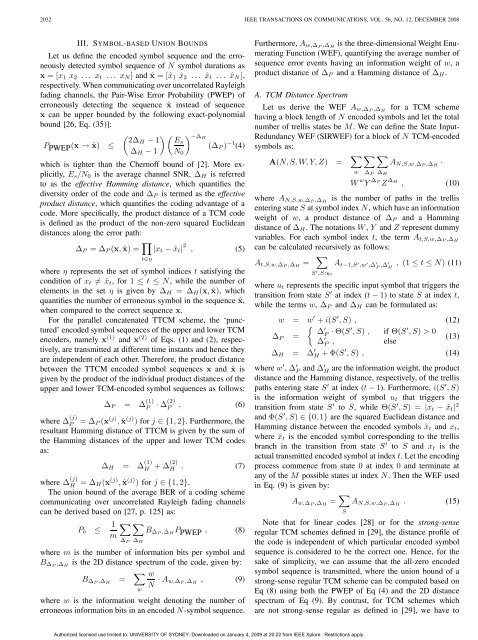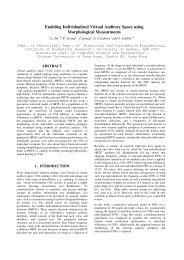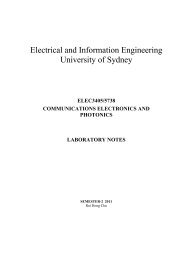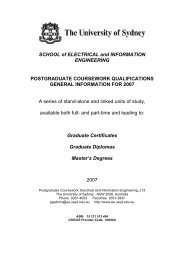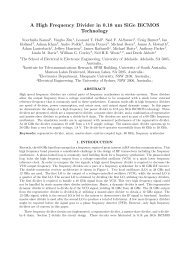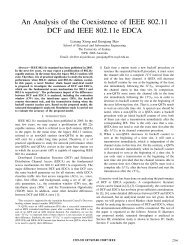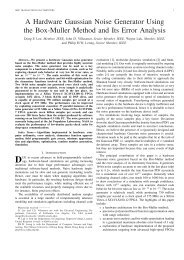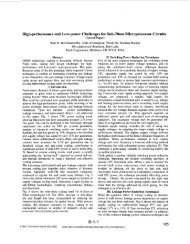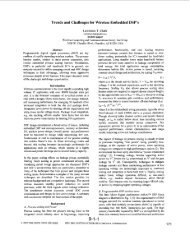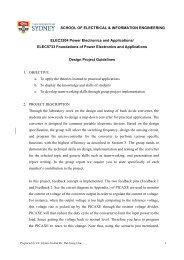Near-capacity turbo trellis coded modulation design based on union ...
Near-capacity turbo trellis coded modulation design based on union ...
Near-capacity turbo trellis coded modulation design based on union ...
You also want an ePaper? Increase the reach of your titles
YUMPU automatically turns print PDFs into web optimized ePapers that Google loves.
2032 IEEE TRANSACTIONS ON COMMUNICATIONS, VOL. 56, NO. 12, DECEMBER 2008<br />
III. SYMBOL-BASED UNION BOUNDS<br />
Let us define the en<str<strong>on</strong>g>coded</str<strong>on</strong>g> symbol sequence and the err<strong>on</strong>eously<br />
detected symbol sequence of N symbol durati<strong>on</strong>s as<br />
x =[x 1 x 2 ... x t ... x N ] and ˆx =[ˆx 1 ˆx 2 ... ˆx t ... ˆx N ],<br />
respectively. When communicating over uncorrelated Rayleigh<br />
fading channels, the Pair-Wise Error Probability (PWEP) of<br />
err<strong>on</strong>eously detecting the sequence ˆx instead of sequence<br />
x can be upper bounded by the following exact-polynomial<br />
bound [26, Eq. (35)]:<br />
( )( ) −ΔH 2ΔH − 1 Es<br />
P PWEP (x → ˆx) ≤<br />
(Δ P ) −1 (4)<br />
Δ H − 1 N 0<br />
which is tighter than the Chernoff bound of [2]. More explicitly,<br />
E s /N 0 is the average channel SNR, Δ H is referred<br />
to as the effective Hamming distance, which quantifies the<br />
diversity order of the code and Δ P is termed as the effective<br />
product distance, which quantifies the coding advantage of a<br />
code. More specifically, the product distance of a TCM code<br />
is defined as the product of the n<strong>on</strong>-zero squared Euclidean<br />
distances al<strong>on</strong>g the error path:<br />
Δ P =Δ P (x, ˆx) = ∏ |x t − ˆx t | 2 , (5)<br />
t∈η<br />
where η represents the set of symbol indices t satisfying the<br />
c<strong>on</strong>diti<strong>on</strong> of x t ≠ˆx t ,for1 ≤ t ≤ N, while the number of<br />
elements in the set η is given by Δ H =Δ H (x, ˆx), which<br />
quantifies the number of err<strong>on</strong>eous symbol in the sequence ˆx,<br />
when compared to the correct sequence x.<br />
For the parallel c<strong>on</strong>catenated TTCM scheme, the ‘punctured’<br />
en<str<strong>on</strong>g>coded</str<strong>on</strong>g> symbol sequences of the upper and lower TCM<br />
encoders, namely x (1) and x (2) of Eqs. (1) and (2), respectively,<br />
are transmitted at different time instants and hence they<br />
are independent of each other. Therefore, the product distance<br />
between the TTCM en<str<strong>on</strong>g>coded</str<strong>on</strong>g> symbol sequences x and ˆx is<br />
given by the product of the individual product distances of the<br />
upper and lower TCM-en<str<strong>on</strong>g>coded</str<strong>on</strong>g> symbol sequences as follows:<br />
Δ P = Δ (1)<br />
P · Δ(2) P , (6)<br />
where Δ (j)<br />
P<br />
=Δ P (x (j) , ˆx (j) ) for j ∈{1, 2}. Furthermore, the<br />
resultant Hamming distance of TTCM is given by the sum of<br />
the Hamming distances of the upper and lower TCM codes<br />
as:<br />
Δ H = Δ (1)<br />
H<br />
+Δ(2) H , (7)<br />
where Δ (j)<br />
H =Δ H(x (j) , ˆx (j) ) for j ∈{1, 2}.<br />
The uni<strong>on</strong> bound of the average BER of a coding scheme<br />
communicating over uncorrelated Rayleigh fading channels<br />
can be derived <str<strong>on</strong>g>based</str<strong>on</strong>g> <strong>on</strong> [27, p. 125] as:<br />
P b ≤ 1 ∑ ∑<br />
B ΔP ,Δ<br />
m<br />
H<br />
P PWEP , (8)<br />
Δ P Δ H<br />
where m is the number of informati<strong>on</strong> bits per symbol and<br />
B ΔP ,Δ H<br />
is the 2D distance spectrum of the code, given by:<br />
B ΔP ,Δ H<br />
= ∑ w<br />
N · A w,Δ P ,Δ H<br />
, (9)<br />
w<br />
where w is the informati<strong>on</strong> weight denoting the number of<br />
err<strong>on</strong>eous informati<strong>on</strong> bits in an en<str<strong>on</strong>g>coded</str<strong>on</strong>g> N-symbol sequence.<br />
Furthermore, A w,ΔP ,Δ H<br />
is the three-dimensi<strong>on</strong>al Weight Enumerating<br />
Functi<strong>on</strong> (WEF), quantifying the average number of<br />
sequence error events having an informati<strong>on</strong> weight of w, a<br />
product distance of Δ P and a Hamming distance of Δ H .<br />
A. TCM Distance Spectrum<br />
Let us derive the WEF A w,ΔP ,Δ H<br />
for a TCM scheme<br />
having a block length of N en<str<strong>on</strong>g>coded</str<strong>on</strong>g> symbols and let the total<br />
number of <str<strong>on</strong>g>trellis</str<strong>on</strong>g> states be M. We can define the State Input-<br />
Redundancy WEF (SIRWEF) for a block of N TCM-en<str<strong>on</strong>g>coded</str<strong>on</strong>g><br />
symbols as:<br />
A(N,S,W,Y,Z) = ∑ ∑ ∑<br />
A N,S,w,ΔP ,Δ H<br />
·<br />
w Δ P Δ H<br />
W w Y ΔP Z ΔH , (10)<br />
where A N,S,w,ΔP ,Δ H<br />
is the number of paths in the <str<strong>on</strong>g>trellis</str<strong>on</strong>g><br />
entering state S at symbol index N, which have an informati<strong>on</strong><br />
weight of w, a product distance of Δ P and a Hamming<br />
distance of Δ H . The notati<strong>on</strong>s W , Y and Z represent dummy<br />
variables. For each symbol index t, thetermA t,S,w,ΔP ,Δ H<br />
can be calculated recursively as follows:<br />
A t,S,w,ΔP ,Δ H<br />
= ∑<br />
, (1 ≤ t ≤ N) (11)<br />
S ′ ,S:u t<br />
A t−1,S′ ,w ′ ,Δ ′ P ,Δ′ H<br />
where u t represents the specific input symbol that triggers the<br />
transiti<strong>on</strong> from state S ′ at index (t − 1) to state S at index t,<br />
while the terms w, Δ P and Δ H can be formulated as:<br />
w = w ′ + i(S ′ ,S) , (12)<br />
{ Δ<br />
′<br />
Δ P = P · Θ(S ′ ,S) , if Θ(S ′ ,S) > 0<br />
Δ ′ P , else (13)<br />
Δ H = Δ ′ H +Φ(S ′ ,S) , (14)<br />
where w ′ , Δ ′ P and Δ′ H are the informati<strong>on</strong> weight, the product<br />
distance and the Hamming distance, respectively, of the <str<strong>on</strong>g>trellis</str<strong>on</strong>g><br />
paths entering state S ′ at index (t − 1). Furthermore, i(S ′ ,S)<br />
is the informati<strong>on</strong> weight of symbol u t that triggers the<br />
transiti<strong>on</strong> from state S ′ to S, while Θ(S ′ ,S)=|x t − ˆx t | 2<br />
and Φ(S ′ ,S) ∈{0, 1} are the squared Euclidean distance and<br />
Hamming distance between the en<str<strong>on</strong>g>coded</str<strong>on</strong>g> symbols ˆx t and x t ,<br />
where ˆx t is the en<str<strong>on</strong>g>coded</str<strong>on</strong>g> symbol corresp<strong>on</strong>ding to the <str<strong>on</strong>g>trellis</str<strong>on</strong>g><br />
branch in the transiti<strong>on</strong> from state S ′ to S and x t is the<br />
actual transmitted en<str<strong>on</strong>g>coded</str<strong>on</strong>g> symbol at index t. Let the encoding<br />
process commence from state 0 at index 0 and terminate at<br />
any of the M possible states at index N. Then the WEF used<br />
in Eq. (9) is given by:<br />
A w,ΔP ,Δ H<br />
= ∑ A N,S,w,ΔP ,Δ H<br />
. (15)<br />
S<br />
Note that for linear codes [28] or for the str<strong>on</strong>g-sense<br />
regular TCM schemes defined in [29], the distance profile of<br />
the code is independent of which particular en<str<strong>on</strong>g>coded</str<strong>on</strong>g> symbol<br />
sequence is c<strong>on</strong>sidered to be the correct <strong>on</strong>e. Hence, for the<br />
sake of simplicity, we can assume that the all-zero en<str<strong>on</strong>g>coded</str<strong>on</strong>g><br />
symbol sequence is transmitted, where the uni<strong>on</strong> bound of a<br />
str<strong>on</strong>g-sense regular TCM scheme can be computed <str<strong>on</strong>g>based</str<strong>on</strong>g> <strong>on</strong><br />
Eq (8) using both the PWEP of Eq (4) and the 2D distance<br />
spectrum of Eq (9). By c<strong>on</strong>trast, for TCM schemes which<br />
are not str<strong>on</strong>g-sense regular as defined in [29], we have to<br />
Authorized licensed use limited to: UNIVERSITY OF SYDNEY. Downloaded <strong>on</strong> January 4, 2009 at 20:22 from IEEE Xplore. Restricti<strong>on</strong>s apply.


